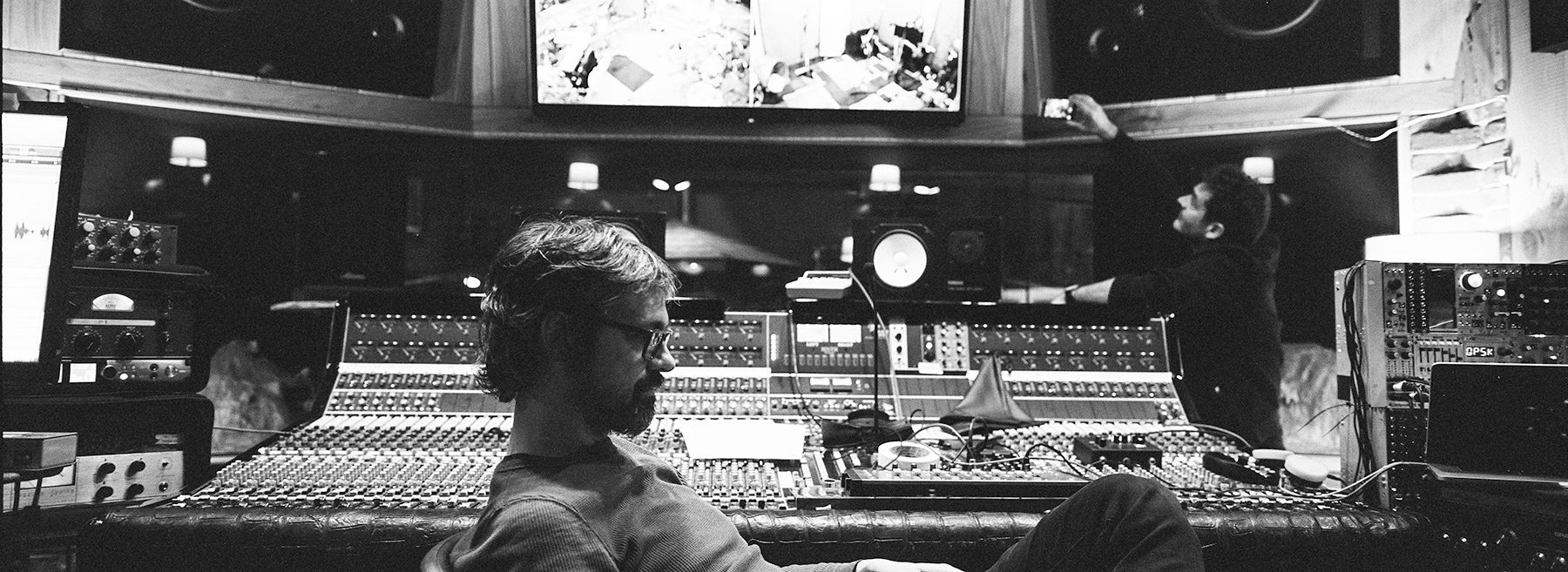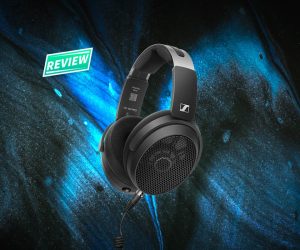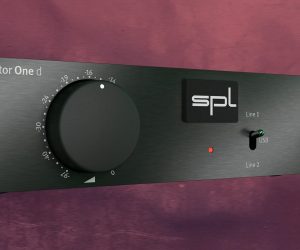
Suck on Light: Recording Boy & Bear
Following a series of successful releases between 2011 and 2015, Australian indie folk-rock band Boy & Bear went quiet. After four years in the wilderness they’re back with a new album, Suck on Light, and new energy.

Artist: Boy & Bear
Album: Suck on Light
After a long hiatus from the studio due to lead singer Dave Hosking’s struggle with chronic illness, Boy & Bear had plenty of time to consider their next long player. Taking up the production reins themselves and bunkering down with uber-engineer Collin Dupuis (Lana Del Ray, The Black Keys) in Nashville was part of that journey. Adapting the production process to suit each song, along with distorting pianos, phasing strings and speeding up tape machines, all helped to deliver a wide-screen cinematic result.
Greg Walker: Given all that has happened since your previous record, what discussions took place within the band about making this new record?
Killian Gavin: Every time you make a record you should hopefully learn a lot. We had a heap of chats over the last couple of years about which recording processes we wanted to use this time, and which ones we wanted to avoid. Looking back over our previous albums and seeing what approaches worked, we made a conscious effort to create an open dialogue and create a brief about what this record needed to be.
I guess the art of performing live in the studio is something we really worked a lot on for the previous record because it was all done live to tape, which I loved. But this time we wanted to bring in more multitracking and more layers. We focussed on nailing performances, and then just finessing what the extra layers should be – sometimes to a dangerous degree of perfectionism.
GW: Was there a long demo process?
KG: We don’t like to push demos too far. There’s nothing worse than getting to the studio and having too many pre-committed tones and sounds that you really want to chase,
because it’s just ‘demo-itis’ and you end up losing so much momentum. It’s not fun in the studio going “how do we re-create that sound from the demo?”
With a demo you want to know what the song is and what you’re aiming for, but you still want be open about where the final recording can go. We’ll have the core arrangement down with sometimes a subtle shift here and there, but in terms of all the colours and the flavours we leave a lot of that until we’re recording the actual album tracks. It means that the sense of exploration and excitement happens when you’re making the real record, not the demo. There’s nothing worse than having boring energy in the studio.
GW: How did you go about finding the right approach for each song?
KG: It really came down to the individual song, so we were quite pragmatic about it. We would look at a track and ask ourselves, “What is the best way to capture this song?” If that meant that a performance and an energy from the band was going to carry most of the load, then we’d have to nail that performance. There were other songs that were much more delicate; we’d multitrack those from the get-go. There were times when the whole band was in the room jamming, and other times where a few of us would put down some sort of an arrangement or a pass of some basic elements and we’d all build on top of that with further takes. Sometimes we’d be going to tape and then bouncing into Pro Tools, and other times we’d go straight to digital.
I’d say in the end it was about 50% band performances and 50% some kind of hybrid multitracking approach. There was a real freedom that we took to find the best approach for each song.
GW: Is using set tempos and click tracks part of your approach?
KG: We’ve actually never used clicks before, we’ve always just played until we get the performance right. We don’t use backing tracks live either so we’ve had a lot of practice getting tempos right, but this time we built a lot of songs off loops. We would create some kind of groove with an electronic or acoustic kit and we’d loop that and use it as a kind of click track with built-in human timing.
The tone of those standard metronome clicks and the way they work, sometimes they’ll be pushing totally the wrong accent when you want to be able to swing it a bit or syncopate something over it. With the loops we made there was always that human element built in to the timing.
GW: I’m curious about the song ‘Work Of Art’. Did that one start with a loop?
KG: Well actually [laughs] I can see why you might think that, but we ended up putting on all that electronic loop stuff after we’d recorded the song. That one was quite a long process. We wrote it and did a demo where we recorded to a loop. We were going to use that loop on the album version, but then we changed the song a bit and the loop wasn’t fitting right anymore. We ended up tracking that song pretty much as a full band performance with some slight slow-downs in the tempo in a few spots which we liked, but then we felt like we were missing that more industrial electronic element to the sound. In the end we went and recorded random pieces of percussion, marimbas, cymbals and drums, and put a lot of distortion on them to get that industrial layer back.
It really came down to the individual song, so we were quite pragmatic about it. We would look at a track and ask ourselves, “What is the best way to capture this song?
PHENOMENAL ENGINEER
GW: How did you choose Collin Dupuis as your engineer and collaborator for the album?
KG: The record we wanted to make was one where we controlled the process and we could make sure the songs were completely idiosyncratic to our band. That meant we wanted to take on the arrangements and producing, obviously, but we also wanted to take on the approach to layering sounds and the way the songs were presented. This led us to wanting to work with a phenomenal engineer rather than a big producer of any kind. We wanted someone to come onboard and be like “I can capture and push sounds in amazing ways, and you guys can lead the creative approach in what you actually record”.
That led us down a long research path where we studied credits and listened to heaps of albums and music, trying to figure out the consistencies of a person who engineered this recording, mixed that recording and co-produced this other recording. We spent months diving into the research because it’s a hard thing to nail…
You can’t just walk into the studio with someone you don’t know that well and expect to walk out with the record you wanted to create.
There are so many unknowns, but Collin ticked all the boxes. His engineering is phenomenal, he’s worked on a lot of big records and he’s worked as a full-time engineer for some big artists as well. He’s done some really unique things, and when we talked to him about how we wanted to track this record with approaches that varied depending on the song, he was completely open to it. He didn’t have any preconceptions about how he wanted to work, and the more we talked the more he felt like the right fit.
PULLING STRINGS
GW: There’s an expansive cinematic quality to the sounds on this record. What was Collin’s contribution to that?
KG: There’s a cinematic kind of ‘wash’ on a lot of songs and that’s massively Collin’s work. We’d be delivering parts and layers and he would push them sonically to these other places and create these beds of sound that sometimes just sit in the background, and other times will jump out at you. He definitely brought a lot to the record in that area. He’s pretty big on using digital plug-ins, and while he did bring in a bunch of old Altec preamps and mixers that he liked to run things through, he definitely embraces the modern digital stuff. He created some really interesting sounds using a whole bunch of different plug-ins.
It kind of sums up the whole record — there was no standard approach. On certain songs he would record to tape and then pitch the tape right down to completely mess with the vocals. There’s a song, ‘Dry Eyes’, where the vocals sound strange because they’ve all been pitched using the tape machine. Collin sped up the tape machine, we recorded the song maybe a minor third higher than it should be and in the appropriate BPM faster than it would end up, and then we slowed the tape machine back down to the right key and we ended up with this really weird distorted drum kit and really fat acoustic guitars. Then we decided to go further, so we slowed the tape down, recorded the vocals like that, and then pitched them back up. Other times we’d record the vocals faster and then slow them down. It was very mathematical with the tape speeds and musical intervals and tempos, I’m glad Collin was in charge because I had no idea how to do that. They’re all live performances, you just have to sing it faster or slower and in a different key. So Collin would be doing old-school analogue stuff like that on one song, the next track he’d be pulling out MXR distortion pedals to run the piano through, then he’d be dialling in plug-ins. There was no rhyme or reason, just whatever sounded good for that song.
GW: There are some unusual string sounds on this record. How did you go about creating them?
KG: We recorded real strings for all of the string parts but we felt like sometimes they came out a bit too middle-of-the-road and weren’t adding enough of a quirk, so Collin would treat those sounds and push them really hard.
He was using a lot of phasers and distortions to create these really unique textures. He pretty much did that on 100% of the strings so they really had their own sonic thing. He’s always got a really solid ear for tweaking things and making them sound unique.
LONG DISTANCE MIX
GW: Tom Elmhirst mixed the record. Did you attend the sessions?
KG: We ended up doing it long distance. We were recording in Nashville for around seven weeks, then we went home. We weren’t committed to having someone else mix at that stage because Collin’s a great mix engineer, but we thought we’d run a few songs by someone else just to hear an alternate mix. Tom works out of New York and we were back in Australia by that point, so we did the mixes by correspondence.
We had a heap of dialogue with Tom. It’s a little bit difficult mixing that way; the mix revisions for a song might go on for three or four days. Tom would send us a mix, we’d listen and make some notes, get a fresh mix from Tom, make some more notes, and so on until we were all happy with it.
Tom works in a really unique way where he creates a sound for the drums and when he’s happy he’ll run that off as a stereo stem that he can put through his analogue desk, and he might do that for the drums, the keys, the guitars and vocals. What it means is that when it comes to doing recalls in an analogue world he can just load those stereo stems back onto the desk and push things up and down and maybe EQ a little bit further. He can recall analogue mixes really fast, which is obviously handy for everyone.
LOCATION IS EVERYTHING
GW: Each Boy & Bear album has been made in a different studio. How much of an influence does the location and layout of a studio have on the end result?
KG: Heaps! One of the big things we always investigate before we settle on a studio is the lines of sight. We always make sure everybody can see everybody else and have good eye contact. In the studio we used for this recording there were a few vocal booths where we said “Well we can’t use these” and ended up putting the vocals in the bass booth just to have the best possible sight-lines.
The previous album, ‘Limit of Love’, was recorded in the Big Room at Peter Gabriel’s studio. That was hard to beat because of the remoteness and the serenity, but we made the new album, Suck On Light, at Southern Ground in Nashville, for a number of reasons. We made our first album in Nashville and were keen to go back there, and one of the conversations we had while planning this album was about having access to other musicians if we needed them. We ended up having string players on some of the songs for this album, and the fact that we could record them within a day or so after deciding to have strings was a big pro for us. Also, we always try to work in a studio that the engineer or producer has worked in before so that they’re familiar with how the sounds translate out of the room. Collin had worked at Southern Ground a lot and got great results, so we decided to record there.










![[[1]]](https://www.audiotechnology.com/wp-content/uploads/2019/10/1.jpg)
![[[8]] Photo by: Jon Hart](https://www.audiotechnology.com/wp-content/uploads/2019/10/8-1000x500.jpg)
![[[5]] Photo by: Jon Hart](https://www.audiotechnology.com/wp-content/uploads/2019/10/5-1000x500.jpg)
![[[2]] Photo by: Jon Hart](https://www.audiotechnology.com/wp-content/uploads/2019/10/2-1000x500.jpg)
![[[21]] Photo by: Jon Hart](https://www.audiotechnology.com/wp-content/uploads/2019/10/21-1000x500.jpg)














RESPONSES-
Pingback: Suck On Light: Recording Boy & Bear | Gear Report